At a Glance
- The OMM Elkhorn is a versatile minimalist rack that can mount in front or back to nearly any bike, even those without eyelets.
- Instead of rails for panniers, the Elkhorn has mounts for bottle and cargo cages or bolt-on fork bags.
- It’s a perfect rack for bikepackers who can’t or don’t want to run a seat bag but still want to pack relatively light.
- I tested the Elkhorn over 250 rough miles of bikepacking and will definitely be using it again on future trips.
I like to think I’m pretty familiar with the universe of bikepacking cargo options, but occasionally something unexpectedly cool and category-bending comes along. Old Man Mountain’s Elkhorn rack reimagines the cargo rack concept from the ground up with bikepacking at the core, and it’s earned a spot in my setup by brilliantly solving a problem I didn’t know I had.
The lines are blurring in the classic debate of panniers versus bikepacking bags, and the Elkhorn strikes a surprisingly helpful middle ground. I prefer soft bikepacking bags when possible because they help me pack light. On the other end of the spectrum, I’ve lived out of panniers for months while traveling abroad.
But what about medium-size gear loads, especially now that I have a dropper post on my bikepacking bike? There is limited frame space on my small 29er, so soft bags only get me so far (literally). The Elkhorn allows me to carry dry bags or water bottles in cargo cages on the rear, similarly to how I usually load up my fork, for a setup that’s modular, well-organized, and intuitively familiar.
I recently tested the Elkhorn during 250 miles of bikepacking in Baja and I was really impressed. Normally I like to put more miles on my gear before writing a review, but I’m excited about the Elkhorn and I think many bikepackers will find it incredibly practical. The just-right amount of cargo space is appealing on its own, and compatibility with pretty much any bike (even without eyelets) is a huge deal.
I also feel confident recommending the Elkhorn because it’s not my first experience with Old Man Mountain’s racks. I previously ran an OMM Divide (review here) for 3 months and 2000 miles of bikepacking abroad. I’ve used my Divide on two different bikes, one with a thru axle Fit Kit and one with QR. Both those Fit Kits are also compatible with the Elkhorn, so it was easy to reuse my rear axle Fit Kit with the Elkhorn for Baja.
The Elkhorn is one of those items I knew I’d be using again even as I was loading it up for the first time. This review is based on my 250 miles of testing so far, but those miles definitely won’t be the last.
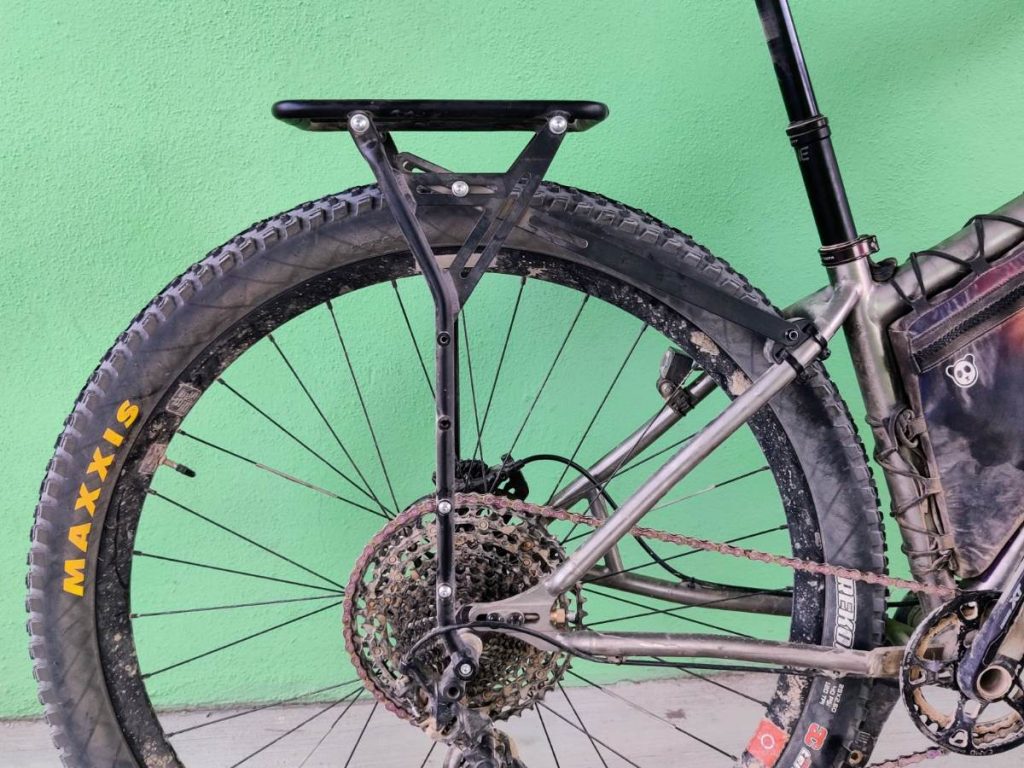
Shop Bikepacking Resources
digital help with planning, riding, and problem solving
Old Man Mountain provided the Elkhorn for testing, but all words and opinions are my own. There are affiliate links in this post which help support this website’s existence. Learn more.
Review Summary
Product: Elkhorn rack from Old Man Mountain
The Elkhorn is a sturdy yet minimalist rack that can mount to nearly any bike in front or rear, even if the bike lacks eyelets. Instead of panniers the Elkhorn takes cargo cages on its uprights for a just-right amount of gear capacity. It’s a great choice for people who need a little more space but don’t want to fuss with a big seat bag, who swap racks between multiple bikes, and/or have a bike that’s hard to fit a rack to.
Price: $168 for rack, plus Fit Kit if needed for axle mounting (between $60 to $80)
Weight: 23oz (652g) tall size, 22oz (623g) short size
Max load: 25 lbs
Max tire size:
29×3.25″ for tall size
27.5×2.8″ or 700cx50mm for short size
Material: aluminum
My rating: 4.8 stars, solves several important problems with minimal drawbacks
What I love about the Elkhorn:
- Cargo capacity is midway between seat bag and panniers
- Can be mounted to bikes with or without rack eyelets
- Can be used as either front or rear rack
- Compatible with standard bottle cages, 3-pack cargo cages, and bolt-on fork bags (no proprietary systems like some of its competitors)
- Solid deck works well with soft or funny-shaped objects
- Highly adjustable to fit nearly any bike
- Sturdy, durable, and reliable
- Allows unrestricted use of dropper seatpost
- Fast and helpful customer support
- Small company based in Bend, OR
Could be better:
- Not cheap, especially if using a Fit Kit
- When axle mounted, rack must be removed from axle in order to remove the wheel, which slightly complicates fixing a flat
- Hex nuts are involved, meaning you might want to carry a small wrench in your repair kit
How I Tested the Elkhorn
I recently had the pleasure of spending two weeks bikepacking in sunny Baja during the depths of winter. I know, poor me! We rode 250ish miles of mostly unpaved mountain roads (sometimes quite chunky or washboarded) and sandy desert washes while making stops along the way for surfing, wind sports, and snorkeling.
The cargo requirements of this trip made the Elkhorn a perfect choice. We needed enough luxuries to enjoy off-bike days at the beach, and up to 5 liters of water at times. But thanks to the warm climate and frequent resupply, we didn’t need too much space. I wanted more capacity than a seat bag (especially the tiny size that works with my dropper post) but less than my REI Link Panniers, which is exactly where the Elkhorn shines.
I ran a tall Elkhorn on the rear of my Chumba Stella rigid mountain bike using a thru axle fit kit. On the sides of the Elkhorn I mounted two Blackburn Outpost cages into which I strapped 5-liter dry bags. On the deck I strapped my inflatable sleeping pad and sandals, and sometimes a 2-liter water bladder (these Hydrapak bladders are collapsible and have loops for straps to keep them in place, super handy).
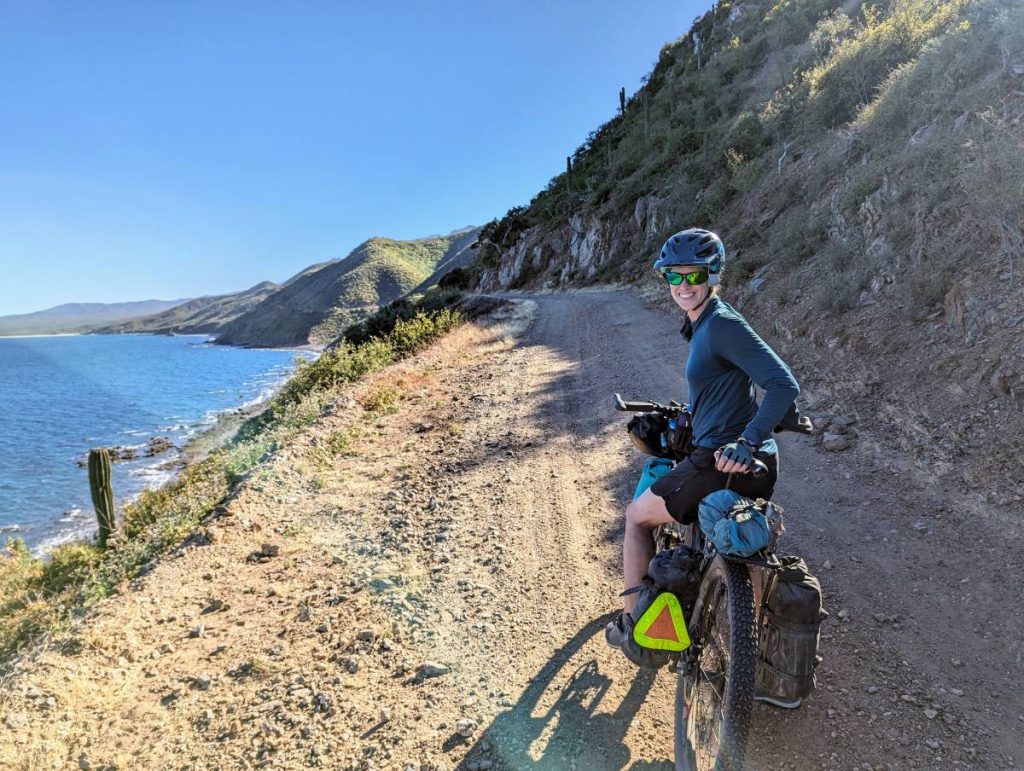
Hard at work testing the Elkhorn in sunny Baja during January. Life is tough.
Sizes
The Elkhorn comes in two sizes: short and tall. The short fits tires up to 27.5 x 2.8″ or 700c x 50mm. The tall fits larger tires up to 29 x 3.25″. Unlike the OMM Divide there isn’t an option for fat tires, though one could argue that if you’re riding a fat tire bike in winter the Divide (specifically the Divide Fat) is a better choice to carry your bulky gear.
As far as I can tell, the tall Elkhorn would work on a bike with smaller tires. The center of gravity would be a little higher than with the appropriately sized short rack, but not a big deal. This means can swap a single tall Elkhorn between your 29er mountain bike and your road bike of gravel bike.
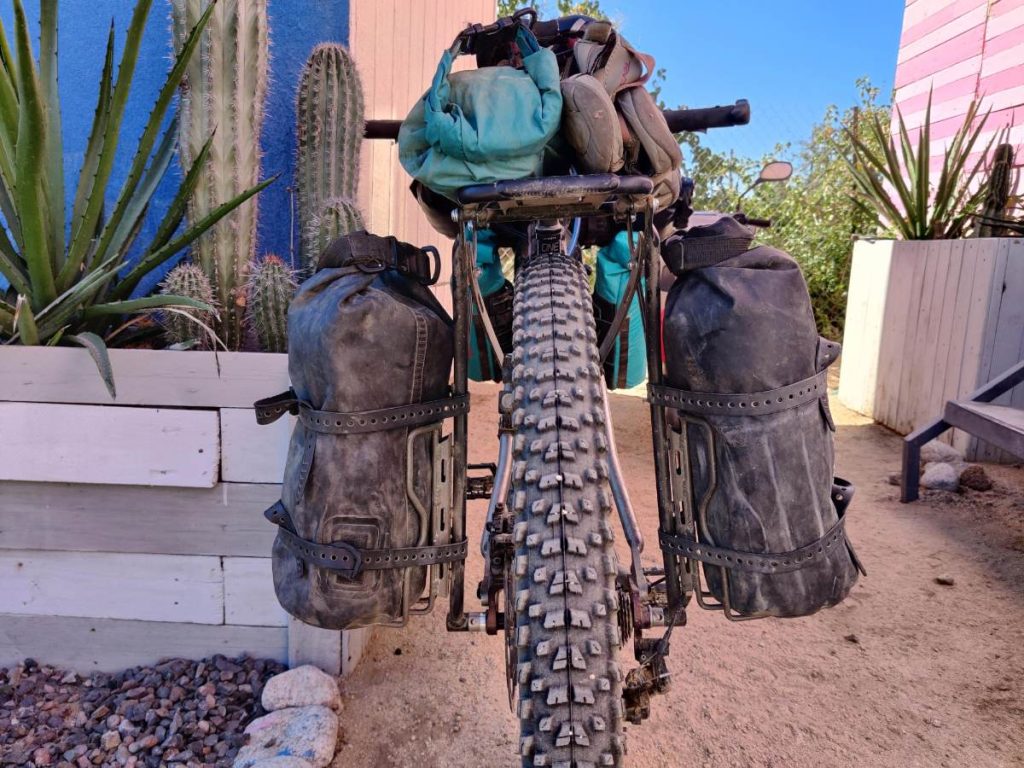
The tall Elkhorn is the right size for my 29×2.6″ tire setup.
Fit Kit System and Bike Compatibility
The Old Man Mountain Elkhorn works with standard rack mounts if your bike has them, and this will save you $60 – $80 since you won’t need a Fit Kit. The rack design is versatile and fits a range of hub spacings; it’ll work on everything from full-squish mountain bikes to road bikes. It can even be used in either front or rear, depending on which set of extenders you use (it comes with both).
The axle-mounted “Fit Kit” system is what really sets Old Man Mountain racks apart. By replacing your bike’s front or rear thru axle with a specially designed version from Robert Axle Project, you can mount OMM’s racks to nearly any bike even without rack mounts. This works for thru axles of pretty much any length and thread configuration, as shown on the extensive list of Fit Kit options, as well as for quick release skewers.
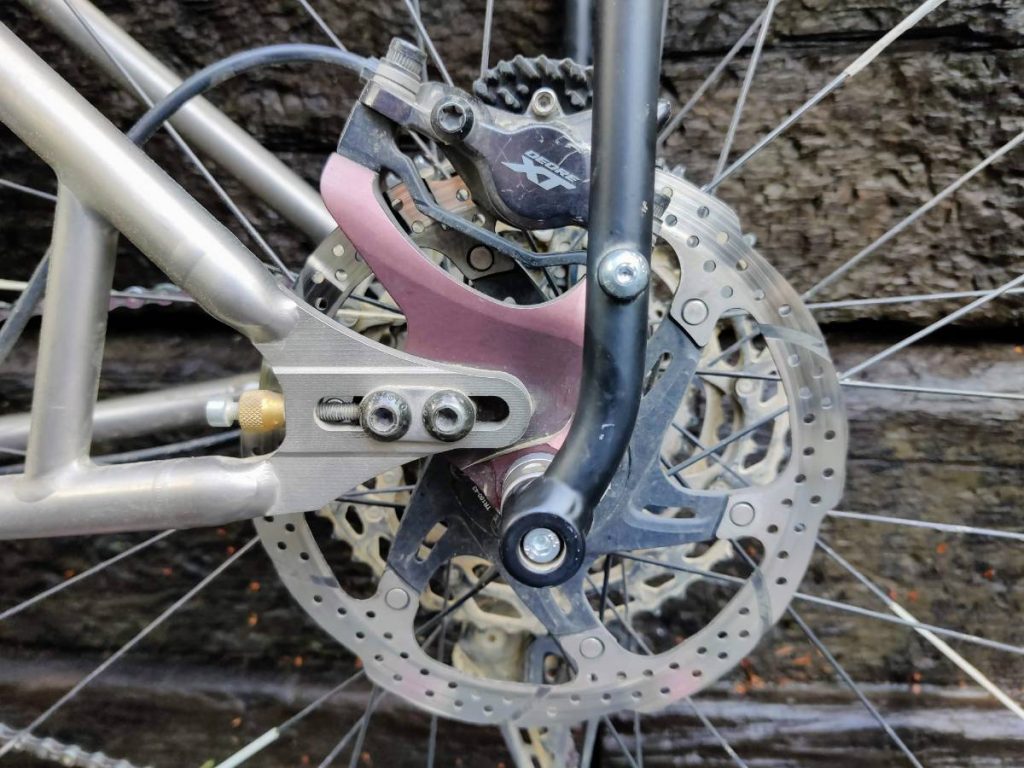
If using a Fit Kit on a bike without eyelets, the Elkhorn bolts onto the end of the replacement axle.
The Fit Kits aren’t cheap, but once you have them they work with all of OMM’s racks (Elkhorn, Divide, Pizza, and the new Axle Pack if it’s a thru axle). I didn’t need a new Fit Kit for the Elkhorn because I reused the one I bought for my Divide.
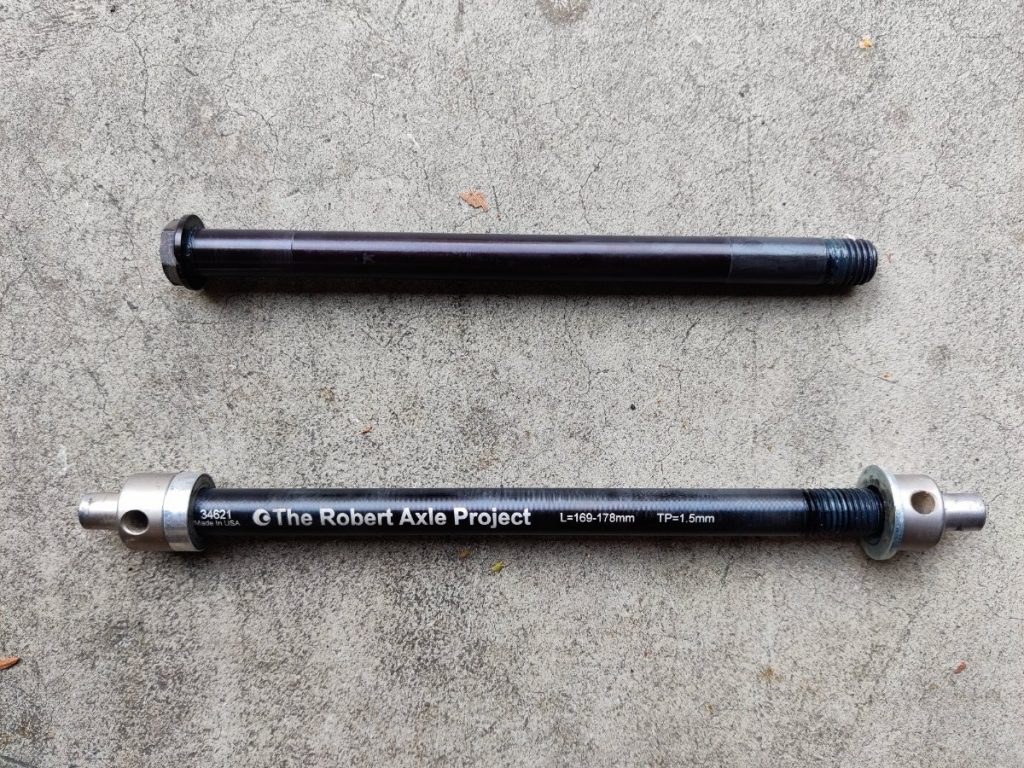
My original rear axle on top, and the Fit Kit replacement axle with rack attachment points on bottom.
Versatility
For those of us who envision bikepacking as a lifelong passion, versatility is a big deal. I have a couple bikes, my husband has bikes, I might someday get other bikes, etc. I love many styles of riding and I’m constantly changing up my gear list, bike setup, and cargo system to best suit each route.
I get a lot of satisfaction from using my gear really thoroughly, so I love that the Elkhorn is kind of like a “forever rack.” I can swap it between my Fargo and Stella with ease, and whatever other bike I end up using next. I don’t usually run a front rack but I’m tempted to try it with the Elkhorn soon. After years of refining my bikepacking setups it feels like the Elkhorn has opened the door to a bunch of new possibilities, which is fun.
Installation
The Elkhorn is fairly simple to install once you figure out what hardware goes where. It ships in a nice box with clever diagrams and labels for all the parts, though oddly the labels on my hardware baggies didn’t match those on the box diagrams. Nevertheless, it wasn’t too hard to figure it out with help from OMM’s instructions.
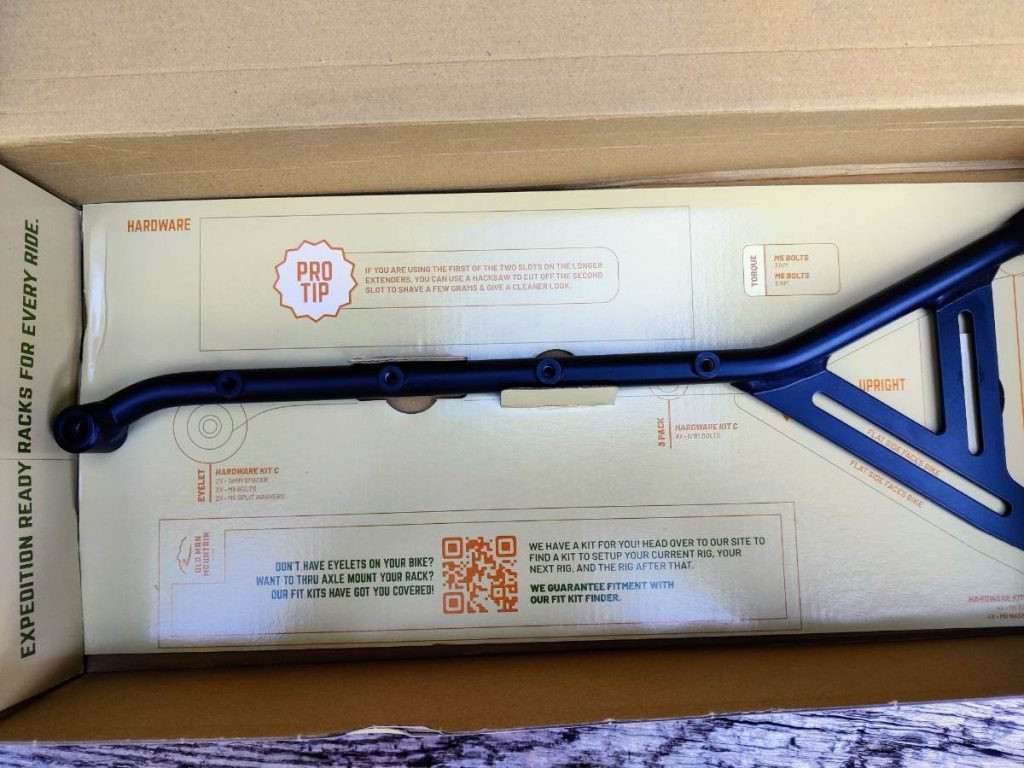
The Elkhorn comes in a box with labels and diagrams to help explain assembly.
With an axle mount installation, you first need to replace your bike’s axle with the one from OMM’s Fit Kit. In my case this required choosing the right spacers from the kit. Then you bolt the rack uprights onto the ends of the axle, then attach the deck to the top. There are a few options for positioning the deck depending on your bike and desired setup.
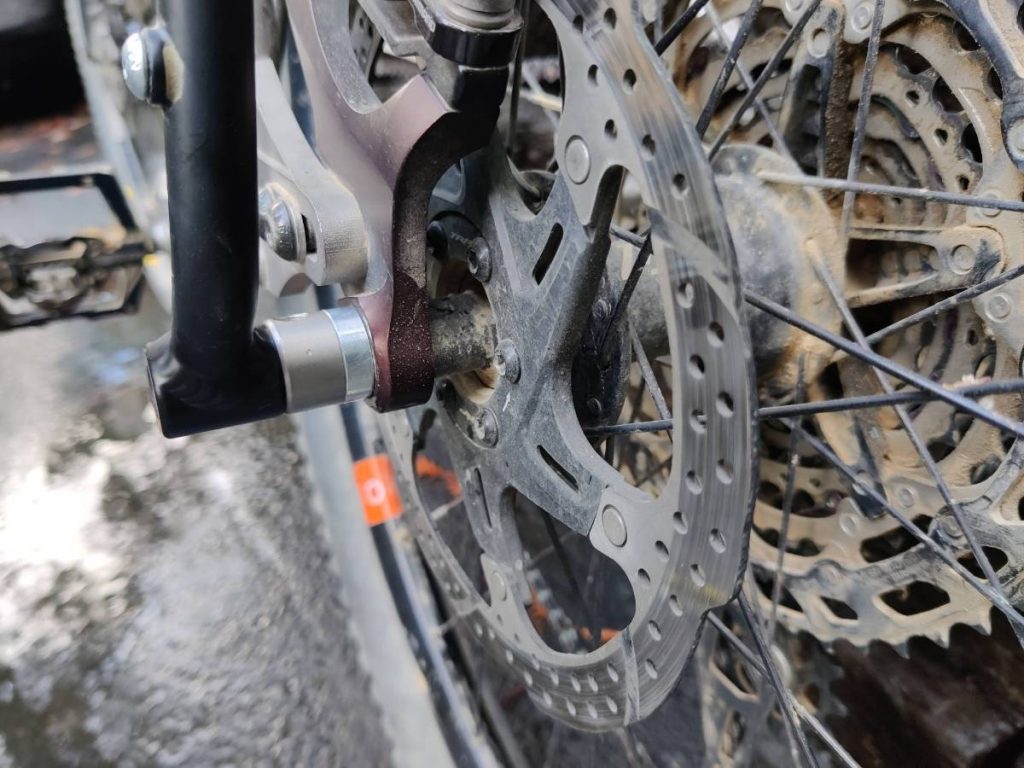
If your bike doesn’t have eyelets, the Elkhorn mounts to a replacement axle available for nearly any bike. Here you see the Elkhorn’s upright (black), the end of the special axle (tan) and a spacer (silver).
Once the rack is assembled, it’s time to attach the extenders to the seat stays (or eyelets or seat post clamp, depending on your setup). I used the same “pucks” I had previously used for my Divide, being careful to reapply protective frame tape (included in the Fit Kit) and snug up the provided special zip ties.
Even if the pucks don’t seem perfectly tight during installation, I’ve found that force from the rack snugs them up once in use and they don’t slip.
Overall I found the Elkhorn faster and easier to install than the Divide since there are no adjustable dropouts.
One minor gripe about both the Elkhorn and the Divide: the rack assembly uses hex nuts. Though they have nylon inserts to prevent rattling loose, there’s always the possibility of needing to tighten or reinstall these on the road, and you wouldn’t want to lose one in the middle of nowhere. I add a small 10mm box wrench to my repair kit when bikepacking with these racks.
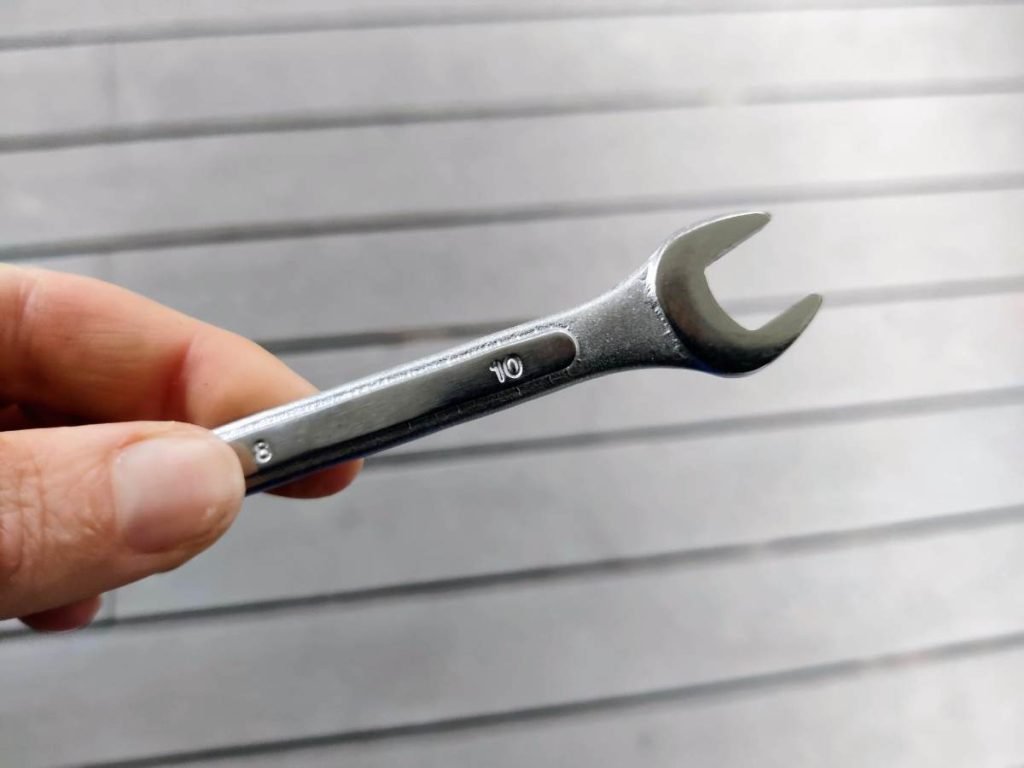
When bikepacking with the Elkhorn I make sure to carry this 10mm box wrench in my repair kit for the hex nuts.
I had an interesting mishap with my Elkhorn, totally my fault but I managed to pack the wrong bolts from my Fit Kit (used previously with my Divide rack and not packed away carefully enough – oops!). When installing the rack in Baja I was unable to get one of the extenders fastened to the puck with the bolt I had, so I used a zip tie instead. Definitely not what OMM intended, but fortunately the design is flexible enough to accommodate this hack and it held up beautifully.
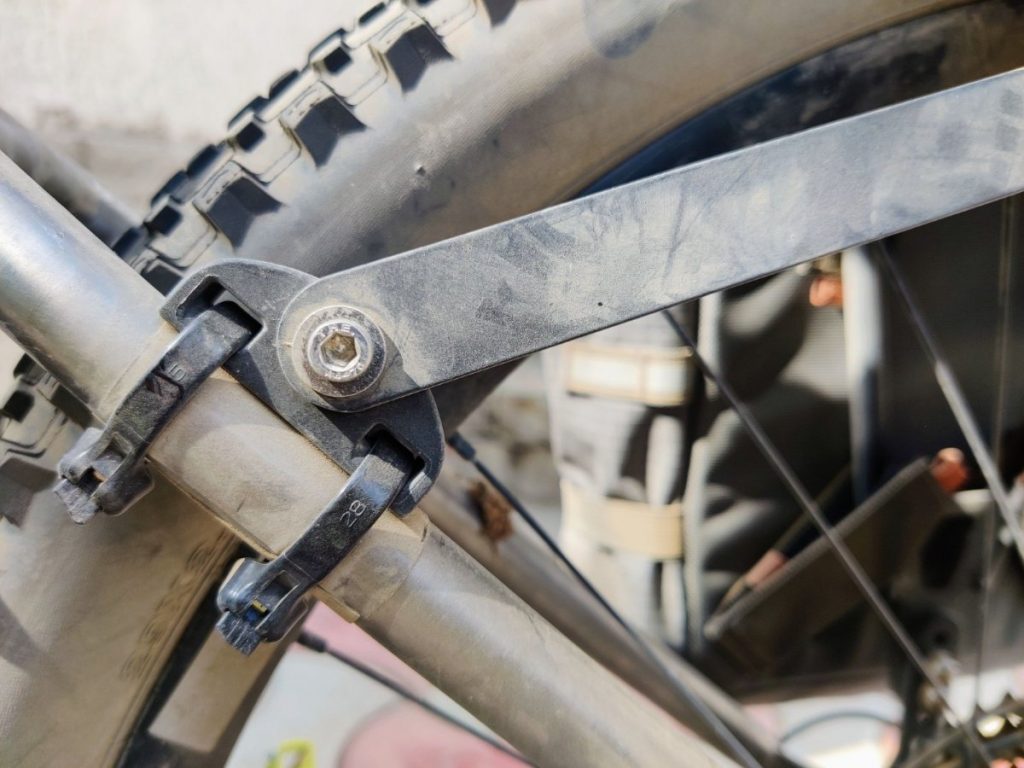
How the Fit Kit pucks are supposed to work (pic of my Divide)
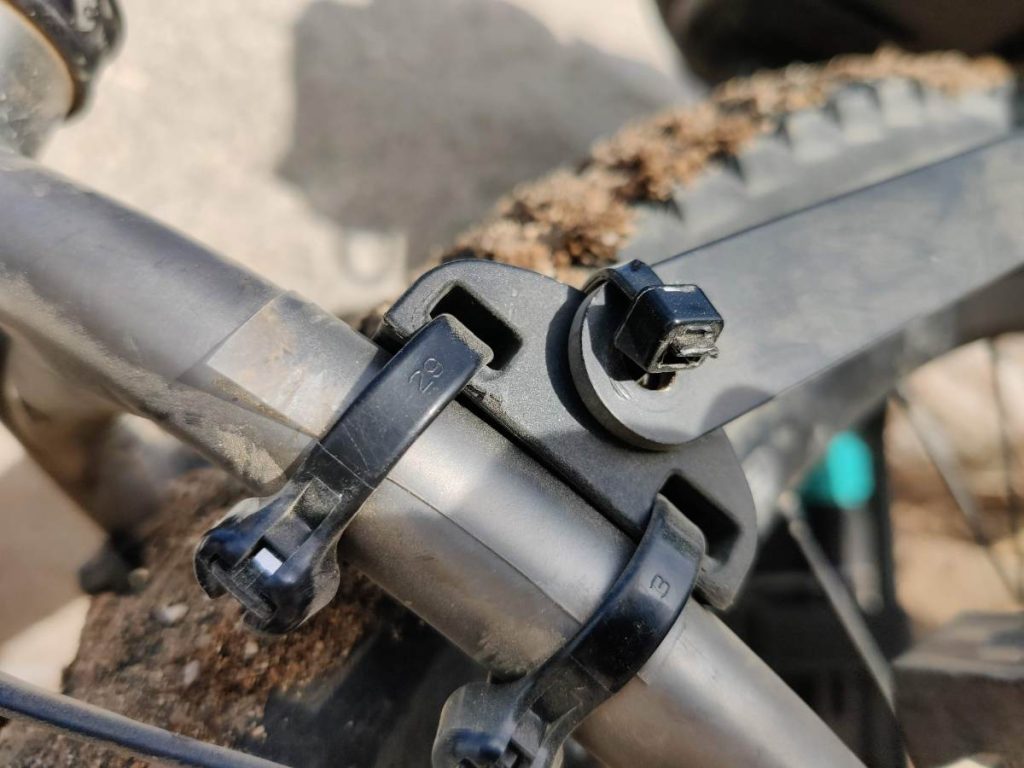
Emergency fix for the bolt I forgot, which worked out great
Weight
The tall Elkhorn weighs 652 g, or 1.44 lbs, with the short extenders used in the front rack configuration. On my scale the tall rack with long extenders and 4 cage mounting bolts weighs 746 g.
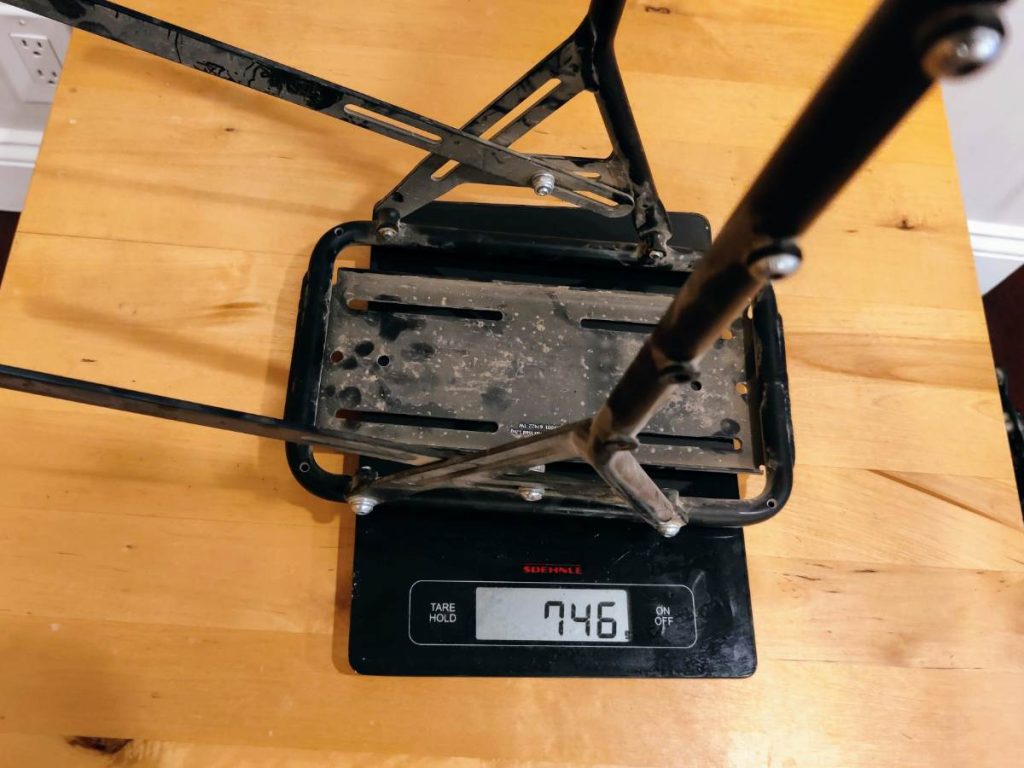
The Elkhorn on my scale with long extenders and four cage bolts
How does this compare to other options? For starters, it’s 200 grams lighter than the OMM Divide rack, which measures 945g on my scale with long extenders. The sturdy Divide is designed to carry a much heavier load (up to 70 pounds when axle mounted!) so its additional weight serves a purpose, but it’s nice to enjoy the Elkhorn’s lighter weight when traveling with a lighter load.
Keep in mind that if you want to carry gear on the sides of the Elkhorn you’ll need to add bottle or cargo cages plus straps. I use Blackburn Outpost cargo cages which weigh 126g each, plus four Voile straps at 30g each, adding up to an additional 372g (0.82 lbs).
Compared to other popular racks, the Elkhorn is a bit heavier but not by much. It’s heavier than the 500g Tumbleweed T Rack (eyelet mount only) and the 600g Tubus Logo Evo (also eyelet mount, rear only). It’s a bit heavier than the more expensive Tailfin Aeropack and much lighter than the more affordable Aeroe Spider (see Alternatives section below).
Compared to a seat bag the Elkhorn is understandably heavier, but not by as much as you might think. The large and sturdy Revelate Spinelock 16 L weighs 1.5 pounds, similar to the Elkhorn rack. Cargo cages and dry bags can add another pound or so to the Elkhorn, but in exchange for that extra pound you get more cargo space, dropper compatibility, ability to swap to a front rack, and more compartmentalized packing.
Though the Elkhorn won’t win awards for the very lightest rack, that’s not its primary mission. The Elkhorn is designed for rugged riding, reliability, and versatility, all of which require a bit of extra material. With that in mind I think the Elkhorn’s weight is very reasonable.
Side Cage Mounts
If you want to run panniers, this isn’t your rack. The Elkhorn’s uprights are designed for mounting bottle and cargo cages, one of its major selling points in my opinion (the other being its universal Fit Kit system).
My tall Elkhorn has four mount points on each upright, allowing for flexible positioning of pretty much any cage with standard bolt spacing. I ran my 2-bolt Outpost cages in the bottom position to keep weight low. The short Elkhorn has three bolt holes, which is still plenty.
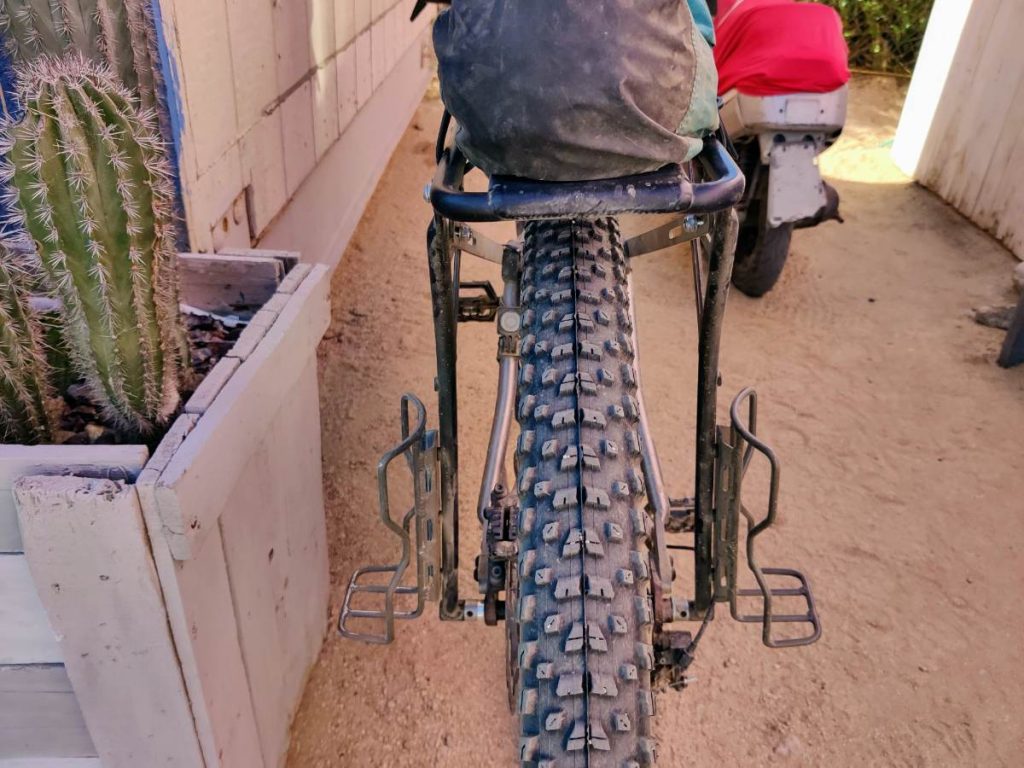
Elkhorn with two Blackburn Outpost cargo cages mounted on the sides
I’m a big fan of cargo cages and dry bags, having run various configurations on my forks for years. So loading up the Elkhorn felt very familiar and I already had the cages, straps, and dry bags in my gear collection. With two bags on my fork and two on my rack, plus deck space, I felt more organized than I usually do when packing for bikepacking. Everything had its place and nothing required too much digging to get to.
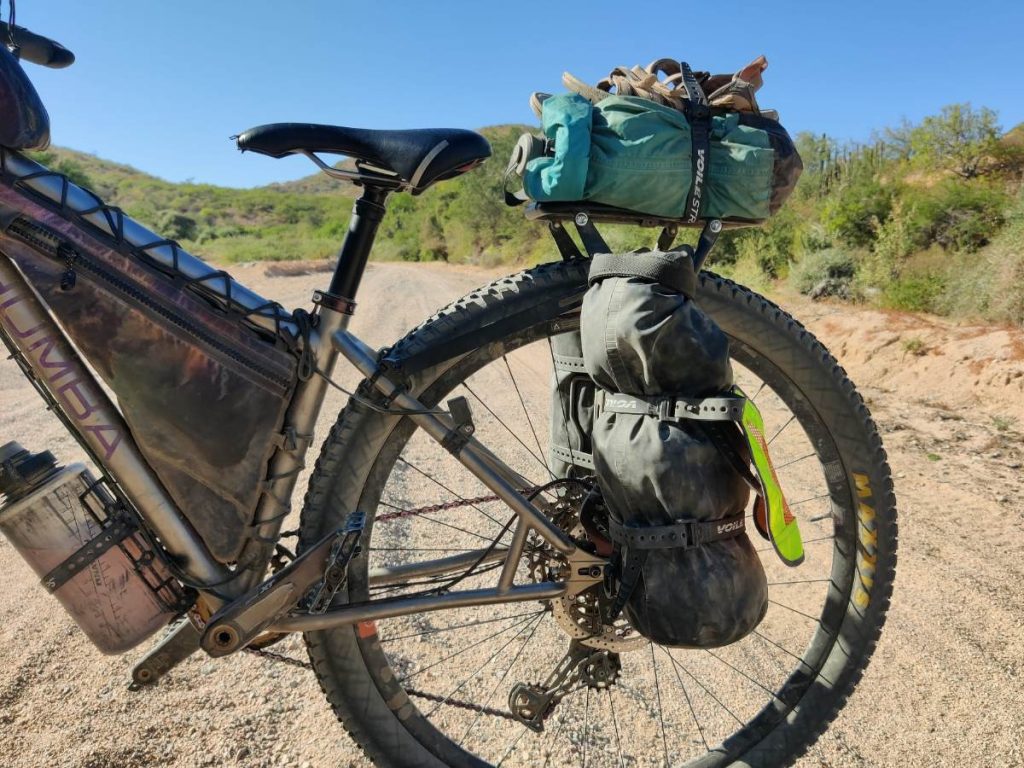
One drawback of rear racks for bikepacking is the way they interfere with hike-a-bike, especially on narrow singletrack. This problem is very obvious when using larger panniers, but how does a svelter Elkhorn setup fare?
The 5 liter dry bags I used with the Elkhorn still graze my legs if I’m not careful while hiking, but it’s better than panniers. The nice thing about the Elkhorn is that you can use smaller bags if you want to minimize this issue, or only load the top deck. You could even run cages without bags on trips with inconsistent food and water carries. Load up a spare dry bag or buy a water bottle at the store when needed, and keep the side cages empty the rest of the time for better hike-a-bike clearance.
To put it another way, the Elkhorn is a modular setup that can be tweaked for each specific ride. Water bottles or dry bags, big bags or small bags, whatever you have in your gear closet can be mixed and matched to fit.
Deck Design
It took me a little while to fully appreciate the Elkhorn’s unique deck design, but now I wouldn’t want it any other way. The wide and mostly solid deck allows for strapping small, oddly shaped, or floppy objects that could slip through gaps in the tubing on more typical rack designs.
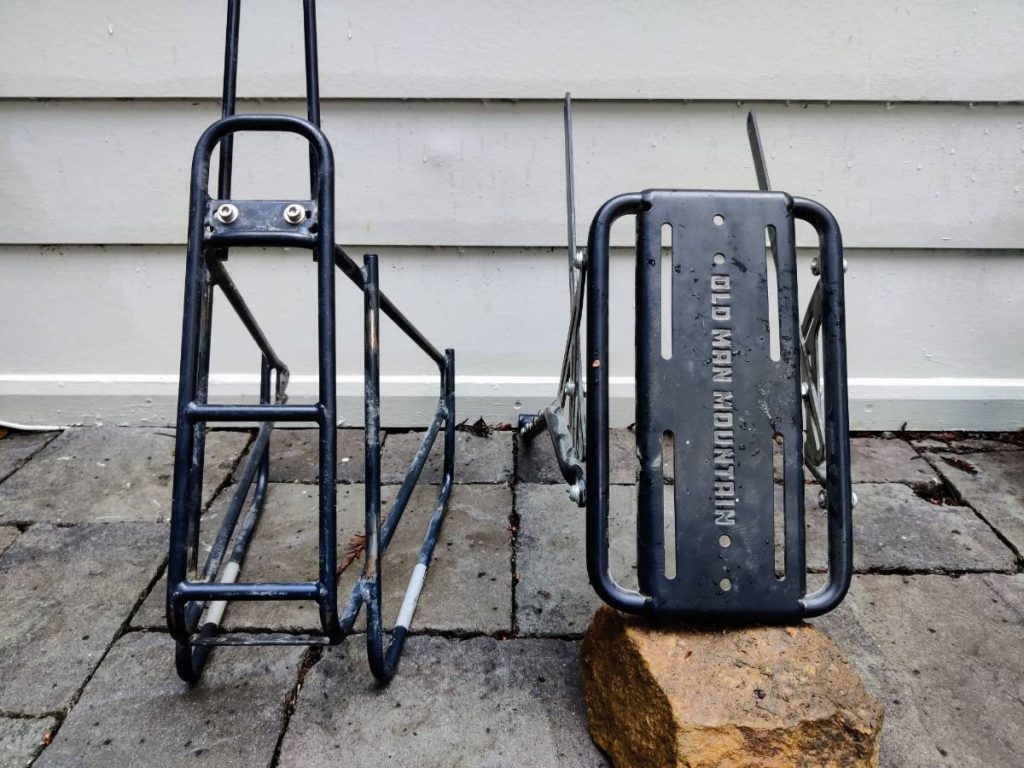
Compared to the Tubus Logo rack (left), the Elkhorn’s (right) wide and solid deck is a more stable platform for items of all shapes and sizes.
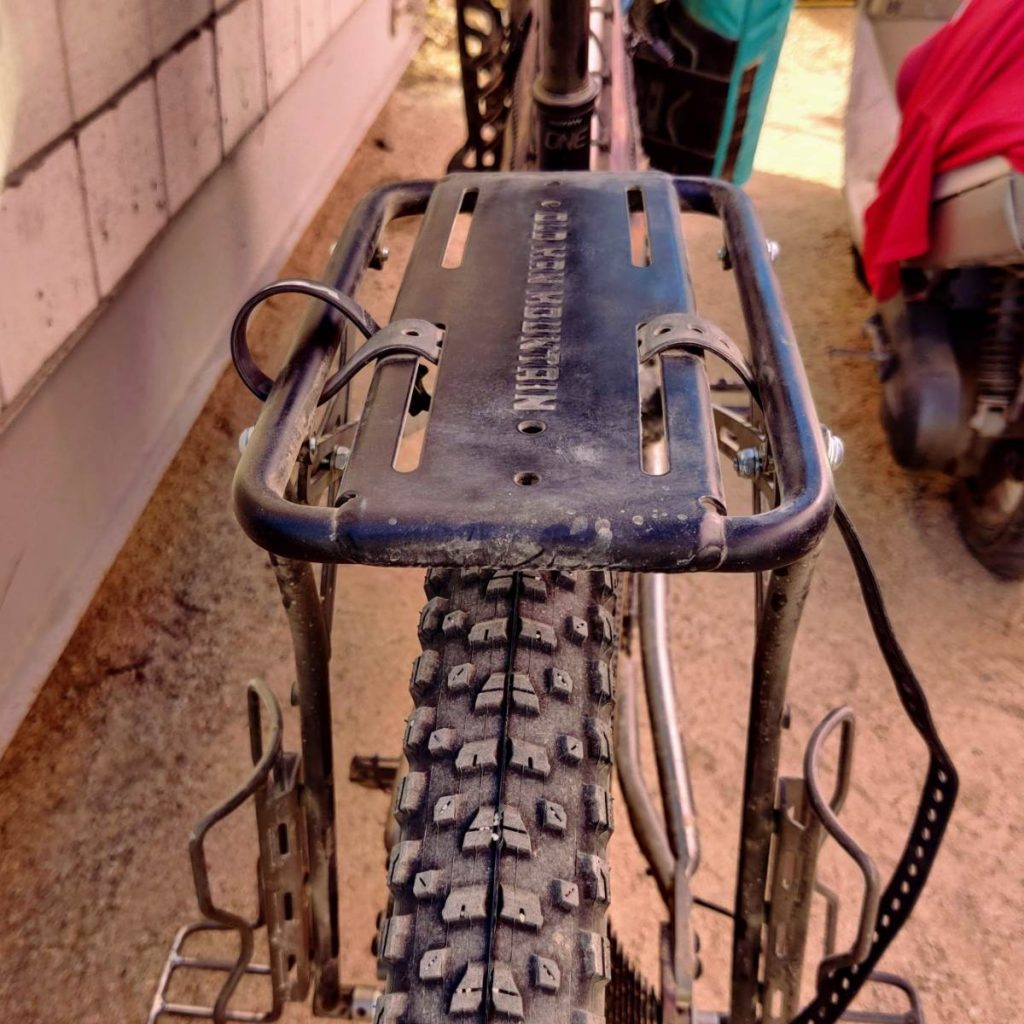
The Elkhorn’s unique deck design is wide, stable, and easy to strap things to.
The solid part of the Elkhorn’s deck measures 10.5″ long by 3.9″ wide. When you include the side tubes the total width is more like 6.3″, which is wider than many racks. It’s the perfect size for my sandals, a 2 liter Hydrapak, and/or my Therm-a-Rest NeoAir sleeping pad. There are multiple ways to strap gear to it, and the wide base makes for a stable load.
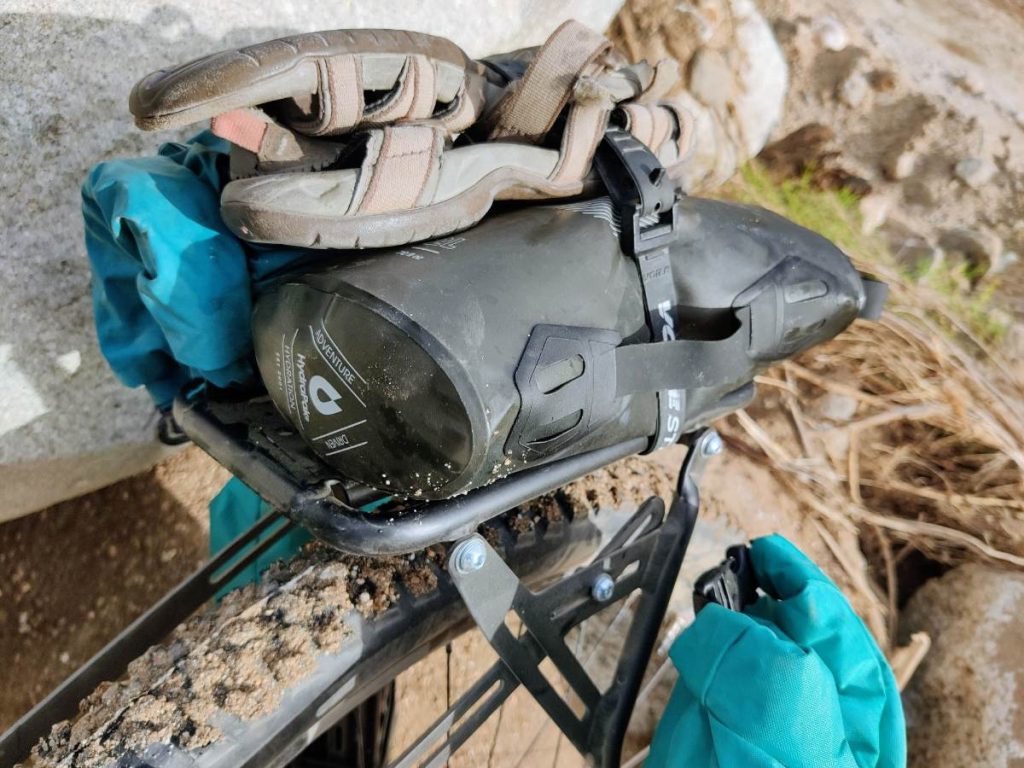
The Elkhorn’s deck loaded up with a sleeping pad, sandals, and two liters of water
The deck’s length a bit short for a standard tent with 18″ poles, though with careful strapping I think it could work. The slots along the sides are nice for retaining straps and keeping them off the tire when the rack is unloaded.
Though you can strap anything you want to the Elkhorn’s deck, it integrates perfectly with OMM’s own Juniper Trunk Bag. This is a premium option for those who need a handy spot for small essentials and value the convenience of a roll-top closure over a cylindrical dry bag.
Removing A Wheel
Here’s something I worried about: Whether for transport or roadside flat fixing, what happens when you need to remove the axle (which the rack is attached to) while the rack is loaded up?
This actually happened to me with the Divide rack (which uses a very similar mounting setup to the Elkhorn) in just about the worst possible scenario. In scorching heat in the middle of nowhere in the Sahara desert I needed to remove my rear wheel to replace a bent derailleur hanger.
It wasn’t that bad. I loosened the bolts at the pucks so the extenders could pivot a bit, unloaded the rack to lighten it, and removed it from the axle and let it just sit there while I removed the wheel and did my work.
In short, it’s a minor inconvenience, but if you’re undertaking a roadside repair it’s probably the least of your worries.
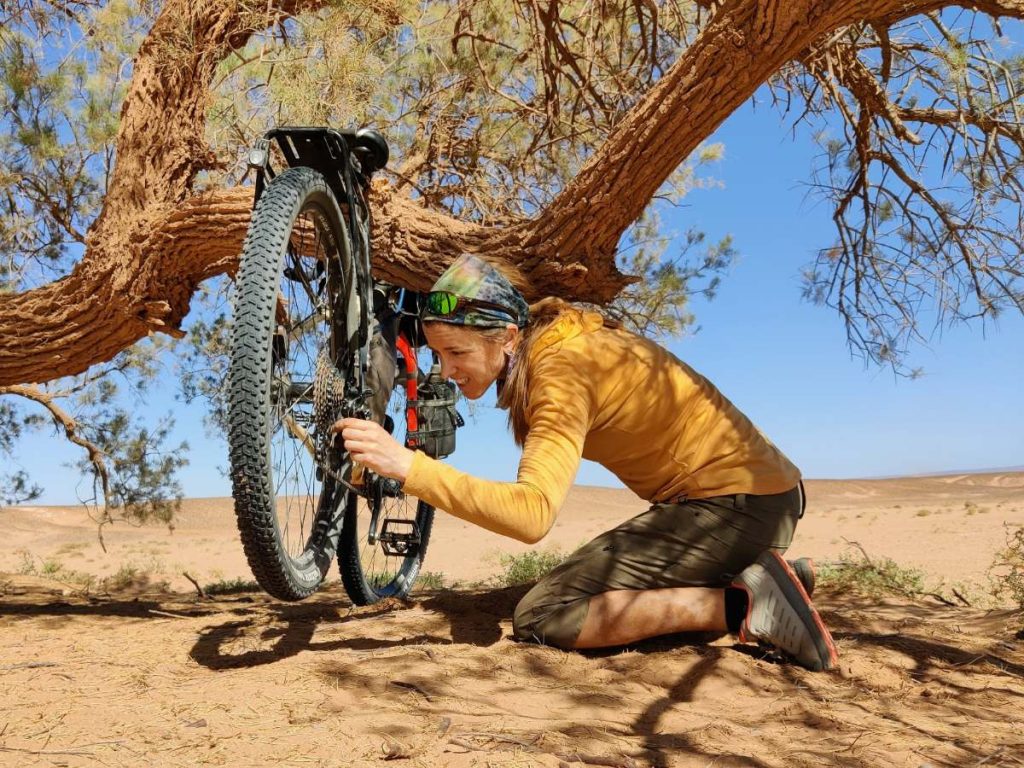
Getting everything put back together and readjusted after needing to remove the rear wheel (and thus the axle rack mounts) in the middle of nowhere
Elkhorn vs. Divide
Now that I’ve tested both the Elkhorn and the Divide, which is best? They’re designed for different purposes and comparing them is an apples to oranges situation. OMM has their own take on this, which is a great place to start.
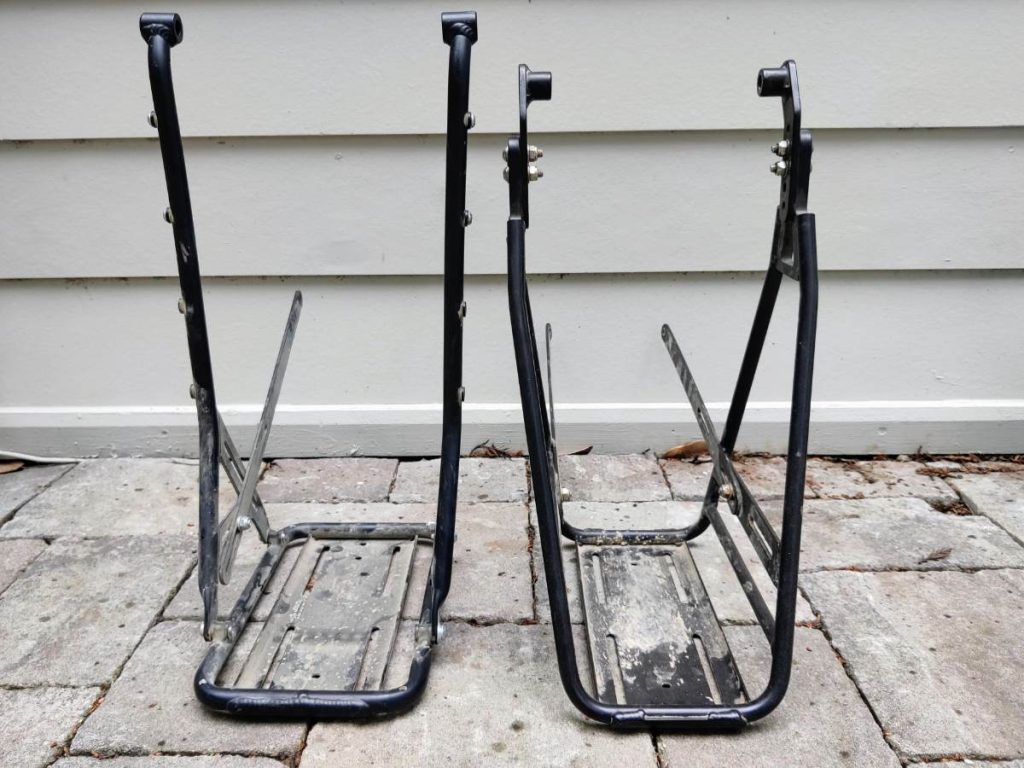
Elkhorn tall (left), Divide (right)
I think the key decision is whether you want to run panniers that mount to rails, especially larger ones. This doesn’t just mean traditional Ortlieb-style, as there are some great off-road-friendly pannier designs these days. I use my Divide with a pair of 18 liter REI Link Panniers on my mountain bike for bigger trips abroad with some long food carries, and for this purpose it’s a unique and amazing solution.
The Divide does have a few downsides though: it’s heavier, the deck is narrower, and it’s a bit more fiddly to set up because of the adjustable dropouts. If you don’t need its burly load carrying capacity and pannier rails, it’s overkill.
The Elkhorn works wonderfully for smaller loads that don’t require panniers while still giving you a ton of options. It’s lighter, simpler, and a bit easier to install. The wide deck and side cage mounts offer ultimate flexibility: leave the sides empty, carry a couple bottles, or load up with dry bags.
It’s worth noting that there is some grey area here as bikepacking cargo options proliferate. You can find mini-panniers that attach with straps over a rack deck, which would probably (? — I haven’t tried) work with the Elkhorn. You can also find small bolt-on panniers, like dry bags that attach directly to 3-pack mounts, that would work perfectly with the Elkhorn. Of course cargo cages with dry bags or fork packs work too.
In my opinion this all means the Elkhorn is the more flexible and versatile option, and is my recommendation as long as you don’t need to carry more than 10 or 15 liters per side. And before you make up your mind, check in on your lightweight bikepacking strategy.
Here’s a short video showing the Elkhorn (left) and Divide (right) to give you a sense of how their shapes compare. On the Divide the side tubes are lower and serve as pannier rails, while on the Elkhorn they are level with the deck.
Minimalist Rack Alternatives
The Elkhorn is, in my opinion, the best balance of cost, weight, and versatility on the market for this style of minimalist rack. If you’re considering the Elkhorn you might also be looking into the alternatives below.
Old Man Mountain Elkhorn: appealing balance of weight, versatility, and cost
- $168, not including Fit Kit ($60 – $80)
- 652g
- front or rear
- axle or eyelet mount
- compatible with standard cargo cages
Tumbleweed T Rack: lightest and most affordable option with similar design to Elkhorn, but requires eyelets
- $130
- 500g
- front or rear
- eyelet mount only
- compatible with standard cargo cages
Aeroe Spider: affordable for a universal fit rack (no special axle needed), but heavy and requires proprietary cradles
- $149 with one cradle
- 979g with one cradle
- rear only
- seat stay mount
- NOT compatible with standard cargo cages, requires additional proprietary (and heavy) cradles
Tailfin Aeropack Alloy: lightest of the universal fit options, but most expensive
- $265+ including axle
- 512g
- rear only
- axle mount
- compatible with standard cargo cages
All these racks have a good reputation among bikepackers, are designed to carry medium cargo loads (more than a seat bag, less than full panniers), and are dropper compatible.
If your bike has eyelets and you’re not expecting to swap to an eyeletless bike in the future, the Tumbleweed T Rack is a compelling alternative to the Elkhorn. If you want eyelet-free compatibility and budget is a major factor, look into the Aeroe Spider. But if you can spare the extra cash for the Elkhorn + Fit Kit(s), it’s a versatile and practical system that will serve you well for many years and many miles.
More Bikepacking Resources
If you liked this review, you might also like these:
Or visit the bikepacking section for lots more.
About the Author
Hi there, I’m Alissa, founder of Exploring Wild. I’ve traveled over 19,000 miles by bike and still can’t stop planning my next ride (and helping you plan yours). Pavement and panniers or singletrack and seat bag, I love it all. On my bike I feel free. Learn more about me here.
Shop Bikepacking Resources
digital help with planning, riding, and problem solving
Bike resources in your inbox?
There’s more where this came from! Sign up here for occasional emails full of inspiration and information about bikepacking and bicycle touring.
Share the Adventure
If you found this article helpful, please consider sharing so more people can benefit from it:
The post Old Man Mountain Elkhorn Rack Review: Flexible, Minimal, Versatile appeared first on Exploring Wild.
https://exploringwild.com/review-old-man-mountain-elkhorn-rack/?utm_source=rss&utm_medium=rss&utm_campaign=review-old-man-mountain-elkhorn-rack
 CampingSurvivalistHuntingFishingExploringHikingPrivacy PolicyTerms And Conditions
CampingSurvivalistHuntingFishingExploringHikingPrivacy PolicyTerms And Conditions
